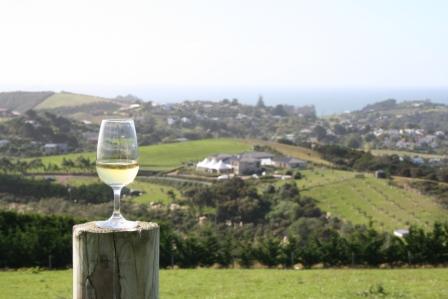Northland| Auckland| Waikato/Bay of Plenty| Gisborne| Hawkes Bay| Wellington/Wairarapa| Nelson| Malborough| Canterbury/Waipara Valley| Central Otago|
- Wine largely produced in ten major wine growing regions spanning 1,600 km (1,000 miles)from latitudes 36°S in the north (Northland) (comparable in latitude to Jerez, Spain), to 45°S (Central Otago) in the south
 (comparable in latitude to Bordeaux, France)
(comparable in latitude to Bordeaux, France) - They are, from north to south Northland, Auckland, Waikato/Bay of Plenty, Gisborne, Hawke’s Bay, Wellington, Nelson, Marlborough, Canterbury/Waipara and Central Otago
- Home to what many wine critics consider the world’s best Sauvignon Blanc
- Wines here are cheaper than their European counterparts despite maintaining a similar level of quality
- The climate in New Zealand is maritime, meaning that the sea moderates the weather producing cooler summers and milder winters than would be expected at similar latitudes in Europe and North America
- The wine regions tend to experience cool nights even in the hottest of summers (The effect of consistently cool nights is to produce fruit which is nearly always high in acidity)
- Wine regions are mostly located in free draining alluvial valleys
In Hawke’s Bay the deposits are known as the Gimblett Gravels (an area of former river bed with very stoney soils)
The affect of the stones is to lower fertility, lower the water table, and act as a heat store that tempers the cool sea breezes and creates a significantly warmer meso-climate
Another soil type is represented in Waipara, Canterbury (the Omihi Hills which are part of the Torlesse group of limestone deposits)
Viticulturalists have planted Pinot Noir here due to French experience of the affinity between the grape type and the chalky soil on the Côte-d’Or
New Zealand Reds are typically made from either a blend of varietals (Cabernet Sauvignon, Merlot, and much less often Cabernet Franc, Petit Verdot and Malbec), or Pinot Noir
Typically “bordeaux blends” come from regions and sub-regions that are relatively hot and dry for New Zealand (86% of production is centred in Hawke’s Bay with Waiheke Island also producing some)

 Masters of Wine
Masters of Wine Wine and Spirits Education Trust
Wine and Spirits Education Trust